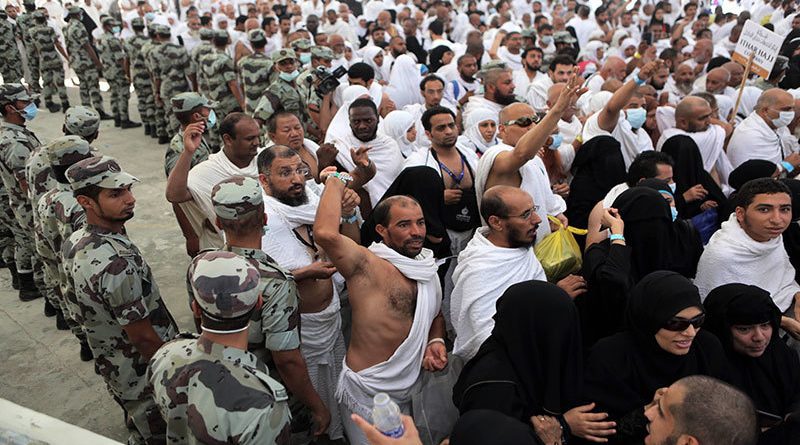Saudi Arabia Puts Pilgrim Safety First Amid Soaring Temperatures as Hajj Begins
Riyadh — As the world’s largest annual pilgrimage approaches, Saudi Arabia has intensified its preparations for Hajj 2025, placing the safety and wellbeing of millions of pilgrims at the heart of its comprehensive national strategy. With temperatures expected to soar between 40 and 45 degrees Celsius, the Kingdom has unveiled a series of advanced measures, including the deployment of artificial intelligence, medical technologies, and enhanced cooling infrastructure, to protect worshippers during the sacred journey.
The Hajj, set to begin on June 4, will see the convergence of pilgrims from over 180 countries on the holy cities of Makkah and Madinah, reaffirming the Kingdom’s enduring role as the custodian of Islam’s holiest sites. But with global temperatures on the rise, Saudi officials are racing against time to prevent heat-related incidents.
“Pilgrims’ Safety Is Our Top Priority”
Speaking ahead of the pilgrimage, Saudi Minister of Hajj and Umrah Dr. Tawfiq Al-Rabiah emphasized the urgent need to adapt to the growing threat of heatwaves.
“One of the big challenges we face is the increasing temperature across the years. This is an issue to which we give top priority,” Al-Rabiah said. He highlighted the Kingdom’s integration of technology and strategic infrastructure to safeguard pilgrims.
Indeed, the urgency of this commitment became evident when the Ministry of Health confirmed five cases of heat exhaustion on Friday among pilgrims performing early rituals. All patients received immediate care and are now in stable condition.
Health teams remain on high alert, stationed throughout the holy sites with rapid response units and mobile clinics. The ministry has issued a series of health advisories urging pilgrims to stay hydrated, avoid direct sunlight, use shaded paths, and report early signs of fatigue or heatstroke. Multilingual public awareness campaigns have been launched to ensure the message reaches every corner of the diverse pilgrim community.
Cooling Infrastructure and High-Tech Surveillance
To alleviate the impact of the blistering summer heat, authorities have added 50,000 square meters of shaded areas across key pilgrimage zones. Over 400 misting fans and cooling stations have been installed, and major walkways have been resurfaced with heat-reflective asphalt to reduce ground temperatures.
Inside the Grand Mosque, renovation and extension projects are being accelerated to reduce congestion and provide ample space for air circulation. The Saudi Food and Drug Authority (SFDA) has also ramped up food and pharmaceutical safety inspections to ensure the quality and safety of consumables.
Dr. Hisham S. Al-Jadhey, CEO of the SFDA, conducted a high-profile inspection of the authority’s operations in Makkah. His visit included tours of food warehouses, medical supply storage facilities, and the SFDA’s advanced Hajj Operations Center.
He reiterated the importance of deploying modern technology, including AI-powered monitoring systems, to oversee field inspections and logistics. “Ensuring the safety of all food and medicine for pilgrims is a great honor and a responsibility we take seriously,” Al-Jadhey stated.
The SFDA’s mobile inspection teams are now equipped with body cameras, real-time data systems, and AI-enhanced tools that monitor storage conditions, regulatory compliance, and product expiration.
Revolutionizing Healthcare with Robotics
In a pioneering move, the Ministry of Health has launched a robotic surgery program at King Abdullah Medical City in Makkah. The initiative, which marks a significant advancement in digital healthcare, aims to deliver precise surgical interventions during Hajj, when healthcare facilities often experience peak demand.
The project is part of a broader vision to transform the healthcare landscape using telemedicine, smart diagnostics, and AI-based triage systems. Emergency hospitals in Mina and other critical locations have been equipped with advanced life-support systems, ICU beds, and multilingual medical staff.
During his inspection, Dr. Al-Jadhey also met with Dr. Abdullah bin Rashoud Al-Algwizani, CEO of the Saudi Public Health Authority (Weqaya), to discuss the ongoing collaboration between their respective institutions. The leaders reviewed plans to integrate public health data with regulatory oversight to better anticipate and respond to potential outbreaks or emergencies during Hajj.
AI-Powered Pilgrimage Management
The Kingdom’s technological transformation has become a cornerstone of Hajj planning. Drones equipped with surveillance cameras are being used to monitor crowds in real time, relaying data to command centers to prevent stampedes and swiftly identify medical emergencies.
“We use advanced AI technologies to do this monitoring and get fast feedback,” said Al-Rabiah. “This allows us to intervene in real time and prevent tragedies before they happen.”
Additionally, AI systems are now tracking weather patterns, air quality, and crowd density, helping authorities make data-driven decisions about crowd control, emergency evacuations, and service distribution.
Tightening Security with Smart Surveillance
To prevent unauthorized individuals from participating in the pilgrimage—a factor blamed for many of the heat-related deaths during last year’s Hajj—the Ministry of Interior has tightened surveillance and access controls.
Using AI-enabled facial recognition, smart checkpoints, and digital permit systems, authorities are monitoring the flow of people into the holy sites. Unauthorized pilgrims attempting to enter without official Hajj permits face fines, detention, and deportation.
Security officials say these measures are essential to manage crowd numbers and ensure the safety of registered pilgrims, especially in extreme weather conditions.
Global Collaboration and Diplomatic Coordination
Behind the scenes, diplomatic missions from dozens of countries are working closely with Saudi agencies to ensure their nationals have access to essential services, emergency assistance, and cultural guidance.
The Ministry of Hajj and Umrah has also expanded its digital portal to streamline pilgrim registration, accommodation booking, and transportation services. The system, now integrated with biometric identification, allows for faster movement through immigration and security checkpoints.
A Vision Rooted in Service
As the Kingdom welcomes the Hajj season, its preparations reflect a broader commitment to Vision 2030 — a national transformation plan that aims to position Saudi Arabia as a hub of innovation and spiritual leadership.
This year’s Hajj, with its fusion of faith, technology, and international cooperation, encapsulates the Kingdom’s evolving role on the global stage. It is a message not only of religious devotion but also of human dignity, compassion, and progress.
By blending centuries-old traditions with 21st-century solutions, Saudi Arabia is setting a global standard for pilgrimage management—ensuring that every pilgrim can perform their rites in safety, comfort, and peace.


